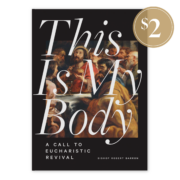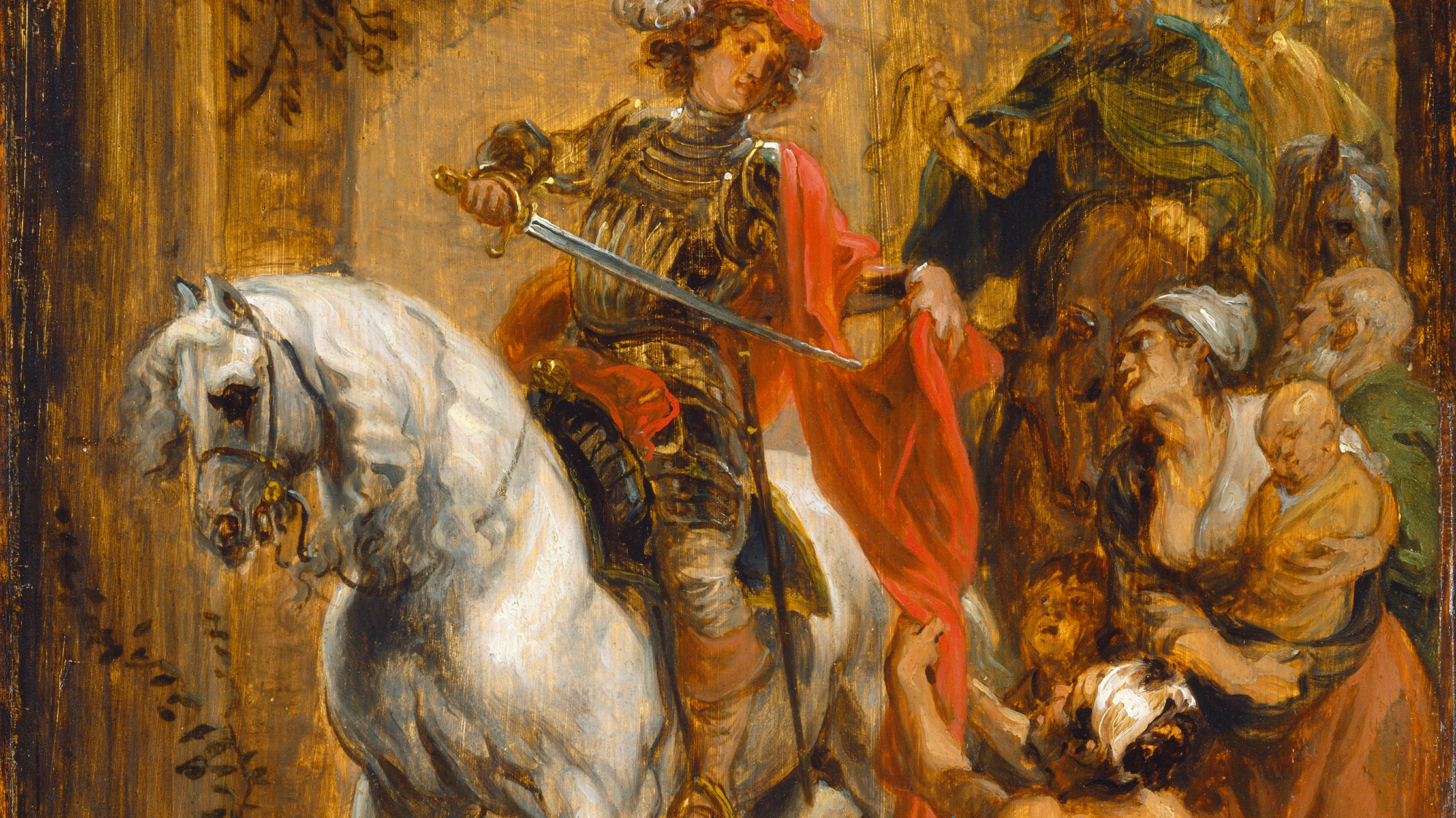Read Part I of “Behind Veterans Day—Contrasting Paths to Peace” here.
Looking behind Veterans Day, we find contrasting paths to peace. The first, the armistice, used limited violence to prevent unlimited violence, which only worked for a short while. Alternatively, at the Last Supper, Jesus offers his peace, which differs from that of the world (John 14:27). His Passion represented the world’s way of making peace through scapegoating. But his Resurrection and the new community that issues forth from it is supposed to make present this better way in which a logic other than that of violence governs. This logic is not an abstraction or program, but rather a concrete plan of action, the following of the incarnate Logos, Jesus. Veterans Day invites us to ponder Saint Martin’s example.
Born into a pagan military family in Pannonia (modern-day Hungary), Martin (316—397) was named after the Roman god of war, Mars. His biographer, Sulpicius Severus (c. 363–c. 425), writes that as a child Martin was drawn to Christianity, but his parents forbade him to enter the catechumenate. At fifteen, he joined a cavalry unit stationed in Gaul. There, one day, Martin encountered a beggar, who that same night was revealed to him in a dream to be Christ; Severus’ account of the dream indicates that Martin was already a catechumen. At the age of twenty, Martin was baptized.
In the midst of a crisis between the empire and the Gauls, Martin professed that his faith in Christ obviated further soldiering: “Hitherto I have served you as a soldier: allow me now to become a soldier to God: let the man who is to serve thee receive thy donative: I am the soldier of Christ: it is not lawful for me to fight.” Against the accusation of cowardice, Martin replied, “If this conduct of mine is ascribed to cowardice, and not to faith, I will take my stand unarmed before the line of battle tomorrow, and in the name of the Lord Jesus, protected by the sign of the cross, and not by shield or helmet, I will safely penetrate the ranks of the enemy.” According to Severus, the Gauls made peace the next day, and Martin was set free.

Martin thereafter became a disciple of St. Hilary of Poitiers, who contended with the Arians, followers of the priest Arius, who, having read the Bible outside of the sacred tradition, concluded that Jesus was neither true God nor true man. Although Arius’ Christology was rejected at the Council of Nicaea, his ideas remained influential, especially in ruling and military circles, since seeing Christ as a demi-god like Hercules was culturally attractive and intelligible. In 356, exile separated Hilary (in Phrygia) from Martin (in Italy) until an imperial decree permitted Hilary’s return to Gaul in 361. After ten years of monastic life, Martin was named bishop of Tours.
Absent from Severus’ account, a popular legend reports that Martin discovered the plot to name him bishop. Martin tried to escape this fate, like other monks before him. Martin hid in a barn full of geese who, as the crowd hunting him passed by, honked, thereby revealing his location. This etiological legend may be seen as a scapegoating myth that justifies—even if comically—the central European custom of eating goose (Martinigansl in German) around St. Martin’s Day.
Esteemed for his humility, simplicity, and goodness, Martin’s exemplary charity extended not only to God and neighbor but also to enemies, as the episode involving Priscillian of Avila (c. 340–385/386) indicates. Priscillian’s biography is uncertain. What can be stated is that he was an educated layman who formulated a heterodox ascetical doctrine that attracted many erudite disciples. Despite a critical doctrinal investigation at a local church council in Saragossa in 380, Priscillian enjoyed sufficient support to become bishop of Avila in 381.
The situation changed in 383 when the new emperor, Maximus (r. 383–388), decided to intervene on behalf of Priscillian’s opponents. Under praetorian prefect Evodius, Priscillian and some of his disciples were found guilty of the charge of sorcery (maleficium)—not heresy—and thereby condemned to death. Severus reports that Pope Siricius, St. Ambrose of Milan, and St. Martin strongly criticized the process inasmuch as such matters belonged to the Church to decide, not the empire. On Priscillian’s behalf, Martin traveled to Trier to persuade Maximus to spare him. Although the emperor initially acquiesced, he later reversed his clemency under pressure from certain Iberian bishops, and condemned Priscillian and some of his disciples to capital punishment in 385/386.

Martin was deeply troubled by this episode, and henceforth refused contact with those bishops who conspired against Priscillian. Only after the emperor had promised to cease persecuting the Priscillians did Martin begin to speak with the other bishops again. In doctrinal controversies up until this case, the Church only resorted to excommunication with the hope of reconciliation and never to capital punishment. Arius, for example, had died of natural causes in 336. With the execution of Priscillian, the state’s interest in religious conformity and its temptation to resort to violence to attain peace trumped the Church’s interest in the salvation of souls.
The redefinition of soldiering from armed conflict to following Jesus through sacrificial love did not stop with Martin. Enthralled with the chivalric romances of his day, Francis of Assisi, whose name testifies to the prestige of the French kingdom, redirected his knightly aspirations to rebuilding the Church as il Poverello, the poor one, inspiring countless men and women, including Pope Francis. Three centuries later, the wounded Basque hidalgo Íñigo, reflecting on the interior motions of his sentiments as he read about Christ and the saints, reoriented his life as Ignatius, going from warrior-knight to warrior-athlete for Christ to found the Jesuits.
We give thanks on this Veterans Day for those who sacrificed youth, health, and peace of mind to protect our liberties and our land. We hope that a day will come when such will never be asked of anyone again; when those who are called to serve to protect the dignity of others may do so in the manner that Jesus has indicated to us, by love of God, neighbor, and, yes, our enemy, even at the cost of our own lives, because this life, as good as it is, is not all that there is.
